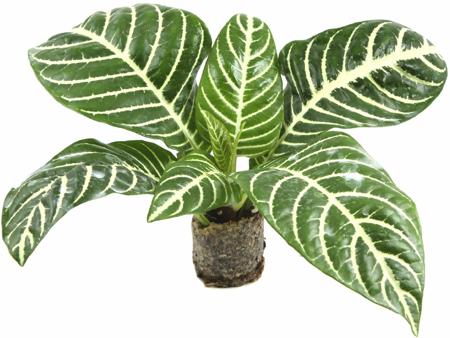Houseplants can not only brighten a space but also purify the air. The genus Calathea comprises countless species that come with bright green, violet-suffused leaves that have vividly-contrasting ribs and veins. Buzzle describes how to take care of a Calathea plant.

Did You Know?Study reports presented by Dutch researchers in 2008 say that hospital patients with indoor plants in their rooms exhibited lower stress levels than patients without them. Apart from providing oxygen, houseplants can significantly reduce the amount of formaldehyde, benzene, and other harmful toxins in the atmosphere.There are over 300 different types of Calathea plants, as various cultivars and hybrids have been developed by researchers worldwide. Calathea species come with beautiful leaves that have different, bright, colorful patterns on the top side. The leaves have red or purple undersides. Sometimes, they are green with a red-violet flush on the undersides. Unfortunately, several species are threatened with extinction, mainly due to habitat destruction.
One of the most popular tropical evergreen species 'Calathea zebra plant' (
Calathea zebrina, commonly called zebra plant) is native to Southeastern Brazil. It is grown for its striking, green-and-cream striped velvety foliage, and not for its purple or white inconspicuous flowers. Its tall, slender stems hold up the large, oval, upright leaves. The leaves are about 12 inches long and are prominently marked. This plant grows larger than the other similar-looking plant called 'prayer plant' (
Maranta leuconeura) or the other similarly named plant, 'zebra plant' (
Aphelandra squarrosa).
Calathea species are endemic to Ecuador, or subtropical/tropical, lowland/highland moist forests. In temperate areas, calathea is often cultivated as a houseplant. It is grown for its showy, variegated leaves. The clump-forming varieties
C. picturata 'Argentea' and
Calathea roseopicta (rose-painted calathea) have gained the Royal Horticultural Society's Award of Garden Merit. Another species that has gained this award is
Calathea zebrina (zebra plant).Quick Facts
 • Common Names
• Common Names: Peacock plant, cathedral, zebra plant, calathea, or prayer plant.
• Type: Evergreen perennial plant.
• Family: Marantaceae.
• Native Range: Tropical Americas.
• Zone: It can be planted outdoors in zones 10 and 11.
• Height: 2-3.5 ft, depends upon the species.
• Spread: 2-3 ft. Some species are clump-forming species.
• Blooming: Some species produce flowers.
• Bloom Description: Some species like
Calathea crocata,
Calathea lancifolia (rattlesnake plant), and cultivars like White Ice, and Brazilian are known for colorful inflorescence.
• Sun: Indirect sun, moderate light.
• Growing Temperature: 60-70° F.
• Prefers: High humidity and indirect lighting (shady room).
• Water: Regular watering during summer, less frequent watering during colder months.
• Maintenance: Medium.
• Suggested Use: Decorative houseplant, table plant.
• Foliage: Large, variegated, green, white, yellow, purple leaves.
• Soil Type: A well-drained potting mix.
• Does Not Tolerate: Heavy watering, temperatures under 55°F, direct sunlight, and arid conditions.Calathea Plant Care Instructions✦ Calatheas need indirect and moderate light. Choose a bright but shaded spot within a warm room. The plant would grow well if you place it near an east or a west window with curtain (or shade from a tree). You may place it in your bathroom, if it is bright.
✦ It cannot withstand sudden changes in temperature, and hot and cold drafts. So do not keep it in front of a heater, an air conditioning vent, or a leaky window.
✦ Add peat-based potting mix (2 parts peat and 1 part perlite) to the pot. The quality of the planting mix ensures good health of the plant.
✦ Once you leave the nursery, see to it that plant roots do not dry out or get damaged before you place the plant into the pot filled with soil.
✦ The soil should hold moisture. It should be well-drained too. Otherwise, the roots would rot.
✦ As explained above, calatheas grow well if the room temperature is between 60-70°F. As the temperature of the room increases, humidity should also be increased. Mist the leaves frequently. You can place a humidifier near the plant or you can place the plant on a tray filled with pebbles. Keep adding water to the pebbles. This will help maintain the humidity around the plant's roots.
✦ See to it that the potting mix is moist. Water the plant regularly during the growing season. Avoid warm or cold water, use water at room temperature. This would help prevent 'shocking' the root system.
✦ Spring is the best season for repotting the calathea plant. As the roots and the plant grow vigorously, you should transfer the plant to a larger pot, after one or two years. Although it is not easy, you can divide the plant when repotting. Place the newly plotted plants in warm environment. Mist and water them regularly until the roots are established.
✦ To ensure proper growth of the plant, feed the plant with a good liquid fertilizer every 15 days, from April to October.
✦ Regular pruning and timely removal of brown leaves can help maintain the height of the plant.Potential Problems
Leaves curling and spots on leaves
This indicates that the plant is not getting enough water. Water it and mist it regularly. It loves moisture.
Brown edges along the leaves
The plant cannot tolerate dry air. It needs humid environment. Lack of moisture results in dryness of the leaves. Moreover, calatheas can be sensitive to fluoride that is commonly found in tap water. So, the leaf tips and edges may turn brown. You can use distilled water or collect rainwater for the plant. A small amount of lime, when added to the planting medium, makes the fluoride more water-soluble.
Leaves turning brown
If you cannot maintain the required humidity, not only the leaf tips and edges but whole leaves would turn brown. The plant would not look attractive if the leaves dry and fall off. Regular misting and watering can help prevent calathea plant leaves from turning yellow or brown.
Limp stems
Over-watering or cold weather can lead to rotten and limp stems. During winter, the plant should not be watered every day. These plants require consistency in their care.
Faded leaves
Exposure to direct sunlight can burn the leaves or it can affect the color of the leaves seriously. It would make them less attractive.
Leaf-eating caterpillars
Caterpillars of the butterfly named 'Purple Owl' (
Caligo beltrao) feed on C. Zebrina.
Attack by pests
Spider mites, scale, mealy bugs, and aphids can affect the health of your plant, especially if the plant is grown in arid conditions. Regular inspection and spraying is essential to avoid diseases. High humidity is essential for the plant, but it also promotes bacterial and fungal growth. Water the plant when the uppermost layer of the soil (an inch below the surface) is dry.In its native range, for example, in some parts of Brazil, the large and tough calathea leaves are used for wrapping fish for transport. In Colombia, Nukak people make containers for the darts, from these leaves. In some villages of Thailand, attractive rice containers are produced from these leaves. They are sold to locals as well as tourists. Thus, these plants not only enhance the beauty of your home but also are useful in various ways. Some calathea flowers can add a heavenly ambiance to their surroundings. For a cozier and a more relaxing ambiance, you can always choose to keep this plant indoors.






 Did You Know?Study reports presented by Dutch researchers in 2008 say that hospital patients with indoor plants in their rooms exhibited lower stress levels than patients without them. Apart from providing oxygen, houseplants can significantly reduce the amount of formaldehyde, benzene, and other harmful toxins in the atmosphere.There are over 300 different types of Calathea plants, as various cultivars and hybrids have been developed by researchers worldwide. Calathea species come with beautiful leaves that have different, bright, colorful patterns on the top side. The leaves have red or purple undersides. Sometimes, they are green with a red-violet flush on the undersides. Unfortunately, several species are threatened with extinction, mainly due to habitat destruction.
Did You Know?Study reports presented by Dutch researchers in 2008 say that hospital patients with indoor plants in their rooms exhibited lower stress levels than patients without them. Apart from providing oxygen, houseplants can significantly reduce the amount of formaldehyde, benzene, and other harmful toxins in the atmosphere.There are over 300 different types of Calathea plants, as various cultivars and hybrids have been developed by researchers worldwide. Calathea species come with beautiful leaves that have different, bright, colorful patterns on the top side. The leaves have red or purple undersides. Sometimes, they are green with a red-violet flush on the undersides. Unfortunately, several species are threatened with extinction, mainly due to habitat destruction.  • Common Names: Peacock plant, cathedral, zebra plant, calathea, or prayer plant.
• Common Names: Peacock plant, cathedral, zebra plant, calathea, or prayer plant.